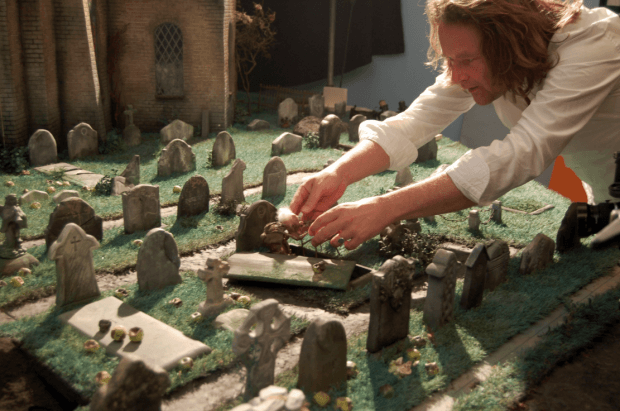Interview with ‘Under the Apple Tree’ director Erik van Schaaik
Erik van Schaaik is one of Holland’s foremost animation directors, working on script writing, short films and children’s series while also soon to direct his first feature film. Starting out at the age of 12 with a super 8 camera, Erik went on to make many films including Vent, The Phantom Of The Cinema and Pecker. His most recent short film Under the Apple Tree has been screened at some of the most prestigious animation festivals including Annecy, Stuttgart and KLIK! as well as winning the Golden Calf Best Short Film and audience award at the Netherlands Film Festival 2015.
Under the Apple Tree is a gothic, stop-motion fable following two bickering brothers and their worm counterparts Aber and Crombie who, having been split apart, will stop at nothing to be reunited. This dark comedy is saturated with talented animation and incredibly skillful puppet and set-makers, setting the film apart as one of the most well-crafted stop-motion films we’ve seen. Erik himself brings an abundance of energy and optimism to his work, evident in the numerous blog and vlog entries he made during the film’s production. Erik took a moment out of his very busy schedule to talk rotten apples and talking worms, as well as about his upcoming feature film Hieronymus.
So just how long had you had the idea for Under the Apple Tree?
I believe around seven years. I was writing just for myself as I wanted to make a horror film but at the time I was also working on television shows and other things, so things went slowly. I put it away for a while and then every time I revisited it, it got a little better. Then there was a long process of trying to find a producer – actually, I started with an English producer and I worked for a long time with her, but in the end it didn’t work out. So I put it away again, then after about five years, the producer of Pedri Animation contacted me. So that’s when I brought them Under the Apple Tree – so we started from there. It took a further two years to gather together the funding, after that we were finally able to start to make a movie.
Were the brothers based on anyone, historical or personal?
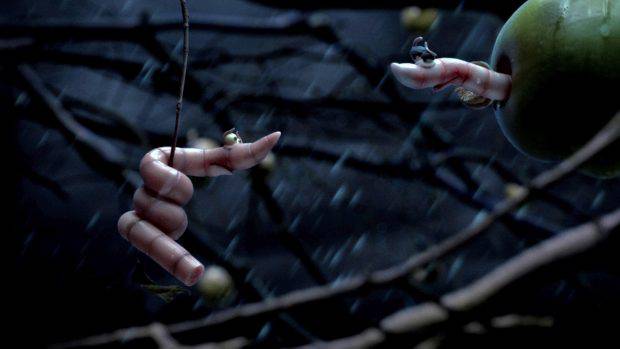
No, when you’re building a story it’s like doing a puzzle. At first the characters weren’t related at all but they became brothers . Originally it was all about worms and the idea that if you chop them in two they will grow a new head and live as two separate beings – which is, of course, not true. So I came up with the idea of two brothers coming from the same worm (Aber and Crombie coming from the name Abercrombie) who then get chopped in two and lost but want to find each other. All the while in the parallel world it made sense for the human story to be about two brothers. So that was the logical step, to make them into brothers in order to complete the puzzle.
It’s obviously a relatively dark story but also deeply funny. You said you’ve always been inspired by the macabre, where did this all come from?
I don’t really know! I have one theory: When I was very young I lived in Singapore and my mother took me to a Hindu religious festival where they put spears through their mouths and body, to thank the god and punish himself or herself. It was very creepy, with all the incense and drums. I love my mother, but this was probably not the best thing to bring a seven-year-old child to. I was in the middle of so much culture and creepy things, I think that’s what led me to wanting to be a special effects artist! I think in general everyone likes creepy things – creepy things are fun. When I was a child I use to watch Something Wicked This Way Comes which was horror for children. I also read Dracula five times, in English, I was so into this menacing thing coming towards our world. So give me a big book and I’ll read something terrifying.
You didn’t make it easy for yourself, with the complexity of shots, scales and environmental obstacles for your characters such as rain and mud, how did you manage to pitch this film?
It was really tough. I noticed that when doing something like an elevator pitch, it was really hard to get across what the story was about, because there was this layer of the story of the worms and the story of the humans, going back and forth between the two, and when you have to pitch this it’s really impossible, so I had trouble doing that. I think because I made a very good animatic, that when I showed it to people they said “Wow, that’s a great story”. Basically you have to see the movie to be able to understand it. I don’t like to make it easy, I don’t back away from difficult shots and we don’t have that much money to make expensive movies but still I wanted to have a sense of good production value for this gothic horror story, so I made a point of making sure it looked really good. I wanted the best animators, the best people on this film and I got some pretty good people involved.
What were the biggest obstacles you faced when making the film, from both/either a story and production point of view?
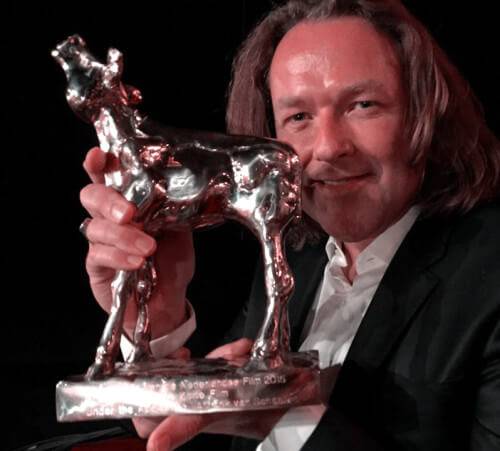
Erik receiving the Golden Calf Award
Money is always the biggest problem. It’s not very interesting to talk about but it’s always the money. Finally when we had money everything went really well, basically. I love my crew, we had a very talented range of people and had a great time making the film but it was hard work and of course we wanted to have a our premiere at the Dutch film festival, so we had a strong deadline to reach. That was the hardest thing. We had a crowdfunding campaign going on so I had to do a lot of videos and ‘making-of’s just to entertain the funders who I was asking for money from, those were hours I was doing on the side. Thankfully we reached our deadline and won the Golden Calf, which is the biggest film prize there is in Holland. So I’m really glad we worked so hard to reach our deadline. We also won the public choice award, so it was definitely celebration time!
It is great to see just how much work went into the film; this really comes across in the multiple vlogs, websites and social media outlets you had for the film. But also your energy, where does that all come from?
I love making movies! Most of the time I do all the work myself, like in my previous film The Phantom of the Cinema, you sit working alone at home until you have a film. I enjoyed this so much; it also gave me so much energy to be able to work with so many people.
The production was split between multiple groups and even countries, with the worm animation being done by a separate team in Belgium. What were the main challenges of directing such a big production internationally?
In Belgium were the worms, basically; in Holland we had the sets and the puppet by Pedri Animation in Holland; we had Sergio Lara Jiménez who is an animator form Spain, who also worked on Anomalisa. We were very lucky to have him, he is a good friend and wow, can he animate! He animated the Priest and the Farmer. So in the end it was split over three countries.
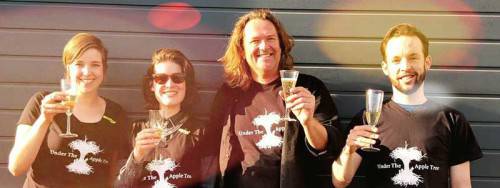
Directing over this many countries was a first for me. It was bit hard at first, when everyone wants information and is working at the same time, all of these teams going forward will also all have questions that I’m supposed to answer at the same time, but I can’t say “Wait till I have the time to give you the answers”, because time is ticking and they need to get on with their work. It was overwhelming, very different to building a film in silence by yourself.
The quality created in both the puppets and the set is exquisite; can you tell me a little about the team that helped make your film and how you chose them?
Pedri created the puppets, and the worms were done by a guy called John Craney who is originally from England, he worked on films like The Lord of the Rings and King Kong so I was really thrilled to have someone of that caliber working on my puppets. I found out it takes a long time to make a puppet like that – 2-3 months! It also takes a lot of money to make them that good. I really enjoyed that I pushed John to make the skin translucent, which he said was a problem because you might see the mechanical head underneath shining through but I wanted to make sure it didn’t have that clay look. I wanted translucency, in 3D you call it sub-surface scattering under the skin, I wanted that look, and we did some tests and it came out so beautifully. I often get asked about how I got that ‘glow’, so I’m very proud that I pushed John, and happy that he got that look working for me.
The film has an almost ethereal feel, in addition to the lighting there is an almost motion-blur quality to the movement of the characters (something rarely seen in stop-motion). How was this created and why did you choose this look for their performance?
There were a lot of action shots, with a lot of movement, and I wanted a camera style that looked hand held, I wanted that dynamic. But when you do stop-motion and you don’t use any motion blur you get strobing, especially when you have it on a big screen. As well as that I like to have my camera really close up to see the faces, I don’t often do wide shots. Also when you animate and it’s very close to the screen it heightens the potential of strobing, so I found a very simple digital tool where after you’ve done your animation you can add a layer which renders motion blur on the sequence. So in some case we used this motion blur which made it look very realistic.
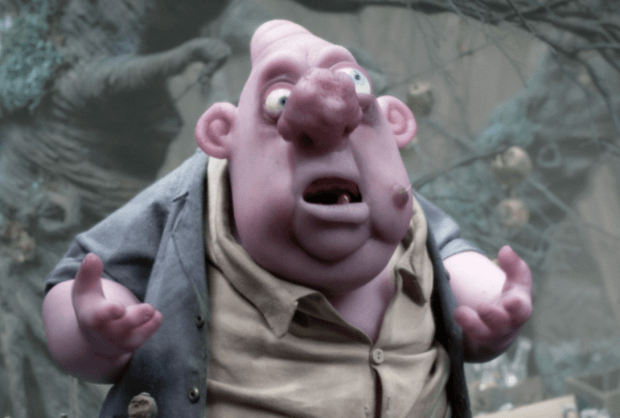
What is next for Under the Apple Tree and you as a director?
Its still playing all over the world and in festivals, you can follow the film’s progress on the website.
I am busy working on my first feature length animated film, which is a CGI film about the famous medieval artist from Holland called Hieronymus Bosch. Bosch of course is the man who did the busy painting full of monsters. I have loved his work all my life, since I was kid and no one has ever made a movie about him or his work. So I wrote a plan and people liked the idea very much so I got the funding to write the script, then we had producers coming on board in Belgium and in Germany and Denmark, so we’re really on our way to getting production in place. I’m putting together the animatic with two other guys and we’re nearing the finish line on the first version of it, which is really thrilling for me. It’s pretty long – I think it’s about two hours at the moment – so I need to cut out some things. It’s a long adventure tale, with a coming-of-age story, for a family audience nine years and up, so not for the super young as it may be a little scary now and then. It’s going to be a thrill-ride!
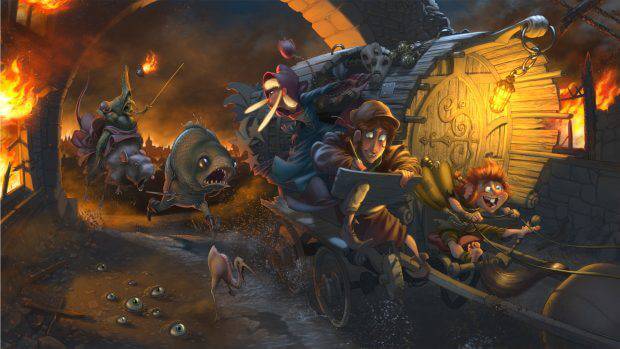
Why have you chosen to make this film in CGI, this time?
It was combination of things. First off, I wanted to do some stop-motion backgrounds with miniature CGI characters inside. We did some tests and it was really too hard, there where so many action sequences and difficult shots, and because we don’t have the years of experience of doing these big films in Holland I just wanted to make it a little easier on ourselves. It’s difficult I know to make a very good CGI film but the idea was that I’m not just going to make the paintings of Bosch move – that would be fun in a short film, but it would be a gimmick in a long film. So I wanted to show a real 3D world that Bosch lived in when he was making these paintings. He was trying to paint in this kind of naïve way and we wanted to see beyond that painting and that canvas and see what he was seeing in real 3D.
Were going to have some incredible sequences. It’s a story with heart and a good message.
To find out what is happening with Under The Apple Tree currently, as well as watching the hours of extra making of material including vlogs, blogs and video head to the movies website here. And you watch the process of Erik’s new film Hieronymous over on the website or the Facebook page.


